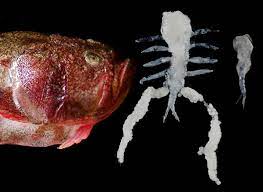New Crustacean Family : New Discovery

Research conducted at the University of Kerala has led to the unprecedented discovery of a new crustacean family off the Indian coast.
- This is the first discovery and description of a new crustacean family from India.
- This parasitic copepod was found to depend upon the Dollfus’ Stargazer (Uranoscopus guttatus), a fish dwelling in depths ranging from 300-550 m off the southwest Indian coast.
- The discovery of the new family has also led to the creation of a new genus and species, Hirodai ohstukai under it.
- These parasitic copepods are known to infest a wide range of hosts, from sponges to marine mammals.
- New isopod species which has been named Glyptothoa sagara; ‘Glypto’ as the fish parasite was found in the deep sea fish Glyptophidium macropus, and ‘sagara’ for ocean.
- Another new isopod crustacean parasite species named Elthusa aquabio was collected from an unknown fish.
- The fourth new species is a 11-12 mm “flesh-penetrating parasitic copepod,” which has been named as Cardiodectes vampire.
- It was found to infest the deep-sea fish Chlorophthalmus corniger.
Crustaceans:
- These are members of the subphylum Crustacea (phylum Arthropoda),
- They are found in a wide range of habitats – most are free-living freshwater or marine animals, but some are terrestrial.
- They are invertebrates with a hard exoskeleton (carapace), a segmented body that is bilaterally symmetrical, more than four pairs of jointed appendages (“legs”) and an open circulatory system.
- Examples: Crabs, lobsters, shrimps, and wood lice etc.




